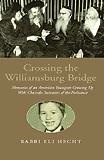From The Peopling of New York City
Crossing the Williamsburg Bridge
Crossing the Williamsburg Bridge, a memoir written by Rabbi Eli Hecht, tells the story of an eight-year-old boy who is without warning moved from his Jewish modern Orthodox community in Bensonhurst to his grandparents’ house in Williamsburg, Brooklyn in the 1950’s. Hecht was thrust into the world of Satmar Hasidism, and had to learn how to quickly adapt to their radically different ways of life. Hecht’s turbulent childhood taught him many things, and he is grateful for the experience.
Growing up in Bensonhurst in the mid-twentieth century, Eli Hecht was an average American child who loved baseball and comic books. He had eight brothers and sisters, and his father was a third generation American. However, his mother’s parents were Hungarian immigrants who arrived in Williamsburg after World War II. When he was eight, Hecht’s parents made the decision to send him to his maternal grandparents to be raised as a Hasid. Hecht describes his experiences living in a community where virtually all the adults were Holocaust survivors:
“The butcher had a tattoo as did the baker and the teacher. Almost everyone had a number. I thought that when you came from Europe you received a number on your arm together with a passport… It was very frightening to hear my traumatized teacher tell us how an SS soldier who would, at times, give a ration of an extra morsel of bread to a child, and then shoot children that stepped out of line asking for bread.” (page 10)
When Hecht arrived in Williamsburg, his life changed dramatically \. He had to dress as a Hasid in a long black kaftan, white knee sox, and black shoes. He was also made to get the classic Hasidic “haircut,” which involved shaving the entire head except for the sideburns. However, Hecht was transformed on the inside as well as the outside. He learned tolerance for diversity and religious values that he still carries with him today. Hecht, who is now national vice-president of the Rabbinical Alliance of America and the regional director of the Chabad Center in the Southern Bay of Southern California, deeply appreciates the sometimes difficult path that led him to Hasidism, as it made him the person who he is today.
Interview with Mark Rosenbaum About Growing Up in Williamsburg
http://www.youtube.com/watch?v=USA52BbQGZg
Image Sources for Mark Rosenbaum Interview
Interview with Shoshana Ehrenfeld About Growing Up in Williamsburg
http://www.youtube.com/watch?v=dWz1pps6NCk
Image Resources for Ehrenfeld Interview
